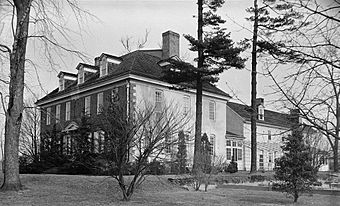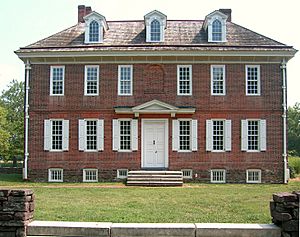Hope Lodge (Whitemarsh Township, Pennsylvania) facts for kids
|
Hope Lodge
|
|

Hope Lodge, circa 1937.
|
|
| Lua error in Module:Location_map at line 420: attempt to index field 'wikibase' (a nil value). | |
| Location | Fort Washington, Pennsylvania |
|---|---|
| Built | 1750 |
| Architect | Edmund Woolley |
| Architectural style | Georgian |
| NRHP reference No. | 72001141 |
Quick facts for kids Significant dates |
|
| Added to NRHP | April 26, 1972 |
Hope Lodge is a historic building located at 553 South Bethlehem Pike in Fort Washington, Pennsylvania, in the United States. This mansion is a great example of Georgian Colonial architecture. It was even used by American soldiers during the 1777 Philadelphia Campaign of the American Revolution.
Contents
The Story of Hope Lodge
Building a Grand Home
Hope Lodge was originally called "Whitemarsh Estate." It is a large country mansion built between 1743 and 1748. A Quaker businessman named Samuel Morris had it built. The famous Philadelphia architect Edmund Woolley designed this beautiful home.
Owners Through the Years
When Samuel Morris passed away in 1770, his brother Joshua sold the property. It was bought by William West, another merchant from Philadelphia.
During the fall of 1777, George Washington and his Continental Army camped nearby for six weeks. Hope Lodge became an important place during this time. It was used as a hospital by Washington's surgeon general, John Cochran. It also served as living quarters for Major General Nathanael Greene.
After William West died in 1784, an English banker named Henry Hope bought the house. He gave it as a wedding gift to his ward, James Watmough. The Watmough family owned the house until 1832. Then, they sold it to their tenant farmer, Jacob Wentz. The Wentz family lived at Hope Lodge for 90 years!
In 1921, a company called Keasbey and Mattison bought the property. They planned to tear down the house to make their nearby limestone quarry bigger. Luckily, William and Alice Degn saved Hope Lodge. They bought it in 1922. In 1957, the ownership of Hope Lodge was given to the Commonwealth of Pennsylvania.
Hope Lodge is officially listed on the U.S. National Register of Historic Places. This means it's recognized as a very important historical site.
Mather Mill used to be part of the Hope Lodge property. However, in 2021, the Commonwealth of Pennsylvania transferred its ownership to a private owner.
Hope Lodge Today
Hope Lodge used to be run by the Pennsylvania Historical and Museum Commission as a museum. In 2009, the site had to close for a while because of state budget cuts.
Today, a non-profit group called the Friends of Hope Lodge manages the site. They work with the Pennsylvania Historical and Museum Commission to keep it open.
The Friends of Hope Lodge host many community events. These include concerts by the Ambler Symphony. They also put on an annual reenactment of the 1777 Whitemarsh Encampment. You can take tours inside the building during certain times of the year, usually from April through October.
Who Owned Hope Lodge?
- 1743 to 1770: Samuel Morris
- 1770 to 1776: Joshua Morris
- 1776 to 1784: William and Mary West
- 1784 to 1832: Watmough Family
- 1832 to 1921: Wentz Family
- 1921 to 1922: Keasbey and Mattison Company
- 1922 to 1957: William and Alice Degn
- 1957 to Present: Pennsylvania Historical and Museum Commission
See also


